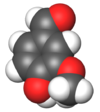Vanillin
|
|
|||
| Names | |||
|---|---|---|---|
|
Preferred IUPAC name
4-Hydroxy-3-methoxybenzaldehyde
|
|||
| Other names
Vanillin
Methyl vanillin Vanillic aldehyde |
|||
| Identifiers | |||
|
121-33-5 |
|||
| 3D model (Jmol) | Interactive image | ||
| 3DMet | B00167 | ||
| 472792 | |||
| ChEBI |
CHEBI:18346 |
||
| ChEMBL |
ChEMBL13883 |
||
| ChemSpider |
13860434 |
||
| ECHA InfoCard | 100.004.060 | ||
| EC Number | 204-465-2 | ||
| 3596 | |||
| 6412 | |||
| KEGG |
D00091 |
||
| MeSH | vanillin | ||
| PubChem | 1183 | ||
| RTECS number | YW5775000 | ||
| UNII |
CHI530446X |
||
|
|||
|
|||
| Properties | |||
| C8H8O3 | |||
| Molar mass | 152.15 g·mol−1 | ||
| Appearance | White crystals | ||
| Odor | Vanilla, Sweet, Balsamic, Pleasant | ||
| Density | 1.056 g cm−3 | ||
| Melting point | 81 to 83 °C; 178 to 181 °F; 354 to 356 K | ||
| Boiling point | 285 °C (545 °F; 558 K) | ||
| 10 g dm−3 | |||
| log P | 1.208 | ||
| Vapor pressure | >1 Pa | ||
| Acidity (pKa) | 7.781 | ||
| Basicity (pKb) | 6.216 | ||
| Structure | |||
| Monoclinic | |||
| Thermochemistry | |||
|
Std enthalpy of
combustion (ΔcH |
−3.828 MJ mol−1 | ||
| Hazards | |||
| Safety data sheet | hazard.com | ||
| GHS pictograms |  |
||
| GHS signal word | WARNING | ||
| H302, H317, H319 | |||
| P280, P305+351+338 | |||
|
EU classification (DSD)
|
|||
| R-phrases | R22 | ||
| NFPA 704 | |||
| Flash point | 147 °C (297 °F; 420 K) | ||
| Related compounds | |||
|
Related compounds
|
Anisaldehyde Eugenol Phenol Vanillyl alcohol |
||
|
Except where otherwise noted, data are given for materials in their standard state (at 25 °C [77 °F], 100 kPa).
|
|||
|
|
|||
| Infobox references | |||
Vanillin is a phenolic aldehyde, which is an organic compound with the molecular formula C8H8O3. Its functional groups include aldehyde, hydroxyl, and ether. It is the primary component of the extract of the vanilla bean. Synthetic vanillin is now used more often than natural vanilla extract as a flavoring agent in foods, beverages, and pharmaceuticals.
Vanillin and ethylvanillin are used by the food industry; ethylvanillin is more expensive, but has a stronger note. It differs from vanillin by having an ethoxy group (–O–CH2CH3) instead of a methoxy group (–O–CH3).
Natural "vanilla extract" is a mixture of several hundred different compounds in addition to vanillin. Artificial vanilla flavoring is often a solution of pure vanillin, usually of synthetic origin. Because of the scarcity and expense of natural vanilla extract, synthetic preparation of its predominant component has long been of interest. The first commercial synthesis of vanillin began with the more readily available natural compound eugenol. Today, artificial vanillin is made either from guaiacol or lignin.
Lignin-based artificial vanilla flavoring is alleged to have a richer flavor profile than oil-based flavoring; the difference is due to the presence of acetovanillone, a minor component in the lignin-derived product that is not found in vanillin synthesized from guaiacol.
Vanilla was cultivated as a flavoring by pre-Columbian Mesoamerican people; at the time of their conquest by Hernán Cortés, the Aztecs used it as a flavoring for chocolate. Europeans became aware of both chocolate and vanilla around 1520.
...
Wikipedia



